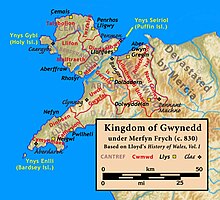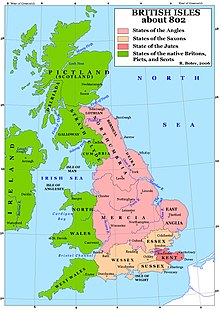Merfyn Frych
Merfyn Frych or Merfyn Frych ap Gwriad (Merfyn the Freckled, Son of Gwriad; † 844 ) was the first of his house to rule the Celtic Kingdom of Gwynedd in northwest Wales from 825 to 844 . But it owes its importance more to the fact that he was the father of Rhodri the Great , who, after centuries of division, managed to unite a large part of Wales in one hand.
origin
origin
Merfyn Frych comes from a very old Celtic ruling family who, according to tradition , can be traced back to the legendary British King Beli Mawr (Beli the Great). He was probably a historical ruler who was the first to succeed in uniting the Celtic tribes of Britain , but his life has become so overgrown with myths that it is difficult to discern historical facts. He lived a generation before the invasion of Britain by Julius Caesar (55 BC), since according to tradition, his son Caswallon or Cassivellaunus (c. 60–48 BC) opposed this as an opponent.
Closer progenitors
Coel Hen (Coel the Old), the Welsh tradition (like the Bonedd Gwŷr y Gogledd , "The Descendants of the Men of the North") around 350 to 420 as king in Hen Ogledd ("the Old North"), that is, in British speaking area of northern England and southern Scotland in Roman or post-Roman Britain, named as the ancestor of some royal dynasties.
Llywarch Hen ap Elidyr (Llywarch the Old, son of Elidyr) was King of Rheged (in north-west England and south-west Scotland) and of the Isle of Man (c. 560–595). As heir to his mother, who was a daughter of Maelgwyn, King of Gwynedd , he was probably able to extend his rule to the island of Anglesey , part of the Kingdom of Gwynedd . Llywarch was less of a ruler than a poet by nature, however, and therefore renounced the crown prematurely and settled as court poet with his relatives, the kings of Gwynedd and those of Powys (see also Englynion y Clyweid , “The Proverbs of the Wise "). Around 582 the Isle of Man was conquered by King Aedan of Dalriada .
parents
Merfyn's father was Gwriad (Guriat) ap Elidyr (Gwriad son of Elidyr), who had re-established himself as King of the Isle of Man around the year 800, which was not easy, since the island was predominantly inhabited by Irish at that time and therefore he was seen as a stranger. Presumably he succeeded in doing this thanks to the support of his father-in-law, the King of Gwynedd. The "Crux Guriad" (Cross of Gwriad) donated by him in Maughold in the north of the Isle of Man (Isle of Man) reminds of Merfyn's father.
Merfyn's mother was Essyllt (Ethyllt), a princess of Gwynedd. She was a daughter of Cynan Dindaethwy ap Rhodri, King of Gwynedd (798-816), whose lineage, according to tradition, went through Coel Hen also except for Cassivellaunus (cl. 60-48 BC) - the British opponent of Julius Caesar - is returned. On it is based Merfyn's later claim to the throne in the kingdom of Gwynedd.
Life
King of the Isle of Man
According to tradition, Merfyn was born on the Isle of Man and succeeded there as King of the Island after the death of his father. His reign as King of the Isle of Man did not last long, as Man and the other islands in western Britain were increasingly settled by Scandinavian Vikings and the Irish-Nordic Gael-Gaedhill from 830 onwards.
King of Quinedd
Through his mother, who came from the royal family of Gwynedd, he had at least a theoretical claim to the crown of this kingdom. Therefore, he followed with personal interest the long-term power struggle that his grandfather Cynan Dindaethwy ap Rhodri Molwynog, who ruled as King of Gwynedd from 798 to 816, fought with his brother, Hywel ap Rhodri Molwynog.
In this family dispute, Merfyn's great-uncle Hywel ultimately won, who drove his brother out in 816 and ruled as King of Gwynedd until 825. After the death of his maternal great-uncle, King Hywel, in 825, Merfyn succeeded - probably for lack of male heirs - as ruler in Quinedd and thus ruled over two kingdoms at the same time.
In Quinedd, the previously ruling dynasty was replaced, which is derived from the semi-mythical King Cunedda Wledig ap Edern (Cunedda the Emperor, son of Edern), who had come from northern Britain to North Wales around 420, where his descendants then around 400 Ruled as kings of Quinedd for years.
Outside Threats
Both kingdoms were exposed to external threats.
Defense against the Vikings
The Isle of Man and the Shetland Islands have been the target of raids by Norwegian Vikings since the end of the 8th century , many of whom settled there permanently, as shown by many place names. Although the Isle of Man was repeatedly plagued by Vikings, Merfyn was able to hold on as a representative of the local Celtic kings for the time being.
According to the Icelandic Landnámabók which describes the settlement of Iceland and the Icelandic Eyrbyggja saga , the Norwegian military leader Ketill flatnefr (Ketill flat nose) conquered the Hebrides on behalf of Harald I. Fairhair King of Norway (872-930) and made himself king there. Man also became part of the Scandinavian domain.
Defense against the Anglo-Saxons
The other territory of Merfins, the Welsh kingdom of Gwinedd, to the east of its islands, was also exposed to external threats. In addition to raids by predatory Vikings, there was a much more serious threat in the guise of its eastern neighbor, the Anglo-Saxon kingdom of Mercia . Thanks to its expansive policy, this had achieved supremacy within the heptarchy of the Anglo-Saxon kingdoms and strove to subject Wales to its hegemony. So it was Beornwulf king of Mercia (823-825) succeeded already 823 to subdue the Welsh Kingdom of Powys, the attack on the neighboring kingdom of Gwynedd was therefore only a matter of time.
Fortunately for Merfyn, Beornwulf grew into a powerful rival around this time in the person of Egbert , King of Wessex (802-839). In an attempt to subjugate this to his supremacy, it came to the battle of Ellandun , near Swindon in Wiltshire , where the troops of King Beornwulf was defeated and he himself was forced to flee. He died shortly thereafter while suppressing a revolt in east Anglia .
This defeat of King Beornwulf's troops was momentous, as it led to the collapse of the hegemony of the Kingdom of Mercia and thus to a reorganization of the balance of power within the Anglo-Saxon heptarchy , with the Kingdom of Wessex now becoming the leading Anglo-Saxon power. The Anglo-Saxon Chronicle records that after the conquest of Mercia, King Egbert was regarded as the seventh “ Bretwalda ” (roughly: High King of Britain).
King Merfyn may at first have felt relief at this development, since the constant threat posed by the Kingdom of Mercia was no longer there. It soon became apparent, however, that this was only a pious wish, as King Egbert of Wessex only saw this victory as a step towards comprehensive hegemony in Britain and therefore the danger of aggression from the east remained. In fact, in 830 he made a successful military advance into Wales, where he overran Powys , but in Gwynedd - where King Merfyn had strengthened the defense - encountered stiff resistance and therefore had to withdraw. This not least because there was an uprising in Mercia behind him at the same time, where Wiglaf King of Mercia (827-829 and 830-840) shook off the dependence on King Egbert and made Mercia again an independent kingdom.
Once again there was a threatening advance by King Egbert of Wessex to conquer the Celtic west of Britain. The campaign of 836 was directed primarily against "West Wales", that is, against Cornwall , with Egbert but at Carthampton (in Somerset ) was defeated by Danish Vikings. In a new campaign, however, he was able to defeat a coalition of Danes and Welsh at Hingston Down in Cornwall in 838. It is not certain that Merfin was involved in this coalition.
In a contemporary supplement to the Historia Brittonum by the historian Nennius , Merfyn is referred to as the "King of the British" - probably somewhat exaggerated. He also appears in the Red Book of Hergest ( Welsh : Llyfr Coch Hergest) in the prophecy of future kings as Merfyn Frych from the land of Manau.
Merfyn died according to the Annales Cambriae in 844 at the Battle of Cyfeillog near Ketell in Wales.
Marriage and offspring
Merfyn was married to Nest Princess of Powys, daughter of Cadell ap Brochfael , King of Powys (773–808), and had the following children:
- Rhodri the Great ( Welsh : Rhodri Mawr ap Merfyn Frych), King of Gwynedd (844-878), King of Powys (854-878) and King of Seisyllwg (855-878)
- Gwriad ap Merfyn Frych
literature
- National Library of Wales, Mostyn Manuscript 117: Bonedd y Arwyr genealogies.
- John Edward Lloyd: A history of Wales from the earliest times to the Edwardian conquest. 2 volumes. Longmans, Green & Co., London et al. 1911, digitized version (vol. 1) , digitized version (vol. 2) .
- Nora K. Chadwick : Celtic Britain (= Ancient Peoples and Places . 34, ZDB -ID 418077-x ). Thames and Hudson, London 1963.
- Mike Ashley: The Mammoth Book of British Kings and Queens. The complete biographical Encyclopedia of the Kings and Queens of Britain. Edited by Julian Lock. 1st Carroll & Graf edition. Carroll & Graf Publishers, New York NY 1998, ISBN 0-7867-0405-5 , p. 151.
- Kari Maund: The Welsh Kings. (The Medieval Rulers of Wales). Tempus, Stroud 2000, ISBN 0-7524-1788-6 .
Web links
- Paul Halsall: Medieval Sourcebook: Nennius: Historia Brittonum (1998, English translation)
- The Avalon Project: History Of The Britons (Historia Brittonum) by Nennius, Translated by JA Giles (1841, English translation)
Individual evidence
- ↑ Mike Ashley : op cit. Chart 1 Celts (1) - Early Britain, p. 67
- ↑ Mike Ashley: op cit. Chart 2 Celts (2) - Men of the North, and p. 422
- ↑ Mike Ashley: op cit. Chart 1 Celts (1) - Early Britain, p. 67 and p. 106
- ↑ Mike Ashley: op cit. P. 422
- ^ Gwynfor Evans: Land of my fathers: 2000 years of Welsh history, Barnes & Noble (1993)
- ↑ Mike Ashley, op. Cit.S. 422
- ↑ Harvcolnb | Parry | 1829 | pp = 63, Brut y Saeson .
- ^ Jean Renaud: "Les Vikings et les Celtes", Éditions Ouest-France, Rennes, 1992, p. 28
- ↑ Swanton, Michael (1996). The Anglo-Saxon Chronicle. New York: Routledge. ISBN 0-415-92129-5 .
- ↑ Paul Halsall: Medieval Sourcebook: Nennius: Historia Brittonum (1998, English translation)
- ↑ The Avalon Project: History Of The Britons (Historia Brittonum) by Nennius, Translated by JA Giles (1841, English translation)
- ^ Skene, William Forbes (1868a), The Four Ancient Books of Wales, I, Edinburgh: Edmonston and Douglas (published 1868), ^ Skene 1868b: 222, Red Book of Hergest
- ↑ Annales Cambriae, An English translation of the original, texts A, B and C, which range from the 5th to the 10th century, can be found under [1] .
- ↑ Davies, John (1990), A History of Wales (First ed.), London: Penguin Group (published 1993), ISBN 0-713-99098-8 , p. 81
| predecessor | Office | successor |
|---|---|---|
| Hywel ap Caradog |
King of Gwynedd 825–844 |
Rhodri the Great |
| personal data | |
|---|---|
| SURNAME | Merfyn Frych |
| ALTERNATIVE NAMES | Merfyn Frich ap Gwriad |
| BRIEF DESCRIPTION | King of Gwynedd (Wales) |
| DATE OF BIRTH | 8th century |
| DATE OF DEATH | 844 |
| Place of death | at Ketell in Wales |


